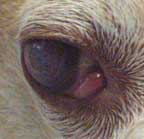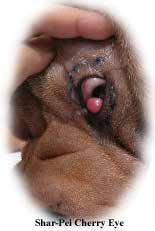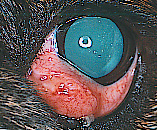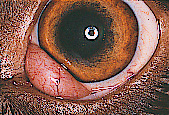|
Cherry Eye or Prolapsed Gland of the Third Eyelid |
|
 |
 |
Within the folds of the lower eyelid, a thin portion of tissue is present
that is often called the "nictitans" or "third eyelid". The third eyelid
is found in most domestic animals. |
|
|
The main orbital lacrimal gland, located beneath a portion of the skull bone, produces the rest of the tears. Unfortunately, the amount of tears produced by each of these glands is variable. The longer the gland is in an abnormal position the greater risk that the gland will be damaged and not fully functional when it is tacked back into place. |
 |
|
 |
In
years past, when a cherry eye occurred, it would be surgically removed. It
is now known that should the main orbital lacrimal gland be damaged later
in life no "backup" for tear production would exist if the prolapsed gland
of the third eyelid is removed. |
|
| Cherry Eye which is inflamed | ||
|
Certain breeds of dogs develop KCS and
cherry eye. These breeds (American
Cocker Spaniel, English Bulldog, Shar Pei, Shih Tzu, Lhasa Apso, and Chow
Chow) frequently develop KCS (Dry
Eye) after removal of the cherry eye condition.
|
 |
|
| Another example of Cherry eye | ||
|
Failure means that the gland will re-prolapse and need a second surgery in about 5 cases out of 100, animal eye specialists have had great success with the tacking procedures . The tacking surgery is certainly more expensive than surgically removing the gland. However, the cost of treating dry eye (examination and medication fees) is much higher over the life of the pet. Despite surgery, dry eye may develop later in life if damage occurs to all of the lacrimal glands. This damage is usually associated with an immune system dysfunction and its occurrence cannot be predicted. |
||
|
Site Researched and Produced by ©Kavishi Shar-Pei |
||
